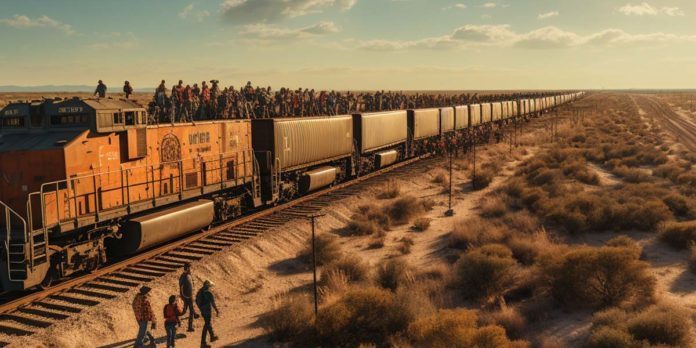
In Ciudad Juárez, hundreds of people faced a night of uncertainty, stranded between the Rio Grande and the imposing border wall in Texas, El Paso Matters reported. These individuals, some of whom had engaged in illegal immigration, sought asylum in the United States.
A diverse group, including men, women, teenagers, and young children, camped near Gate 36 along the border wall. Others found themselves on a narrow strip of land adjacent to the Rio Grande, separated from their goal by a formidable concertina wire fence erected by the Texas National Guard.
Their journey began aboard a cargo train managed by Ferromex, an economical means of travel that offered safety in numbers. Some migrants, primarily from Venezuela, disembarked, hoping to surrender to the U.S. Border Patrol. However, a robust Mexican law enforcement presence, involving municipal police, the National Guard, and the National Migration Institute, thwarted their intentions, forming a human barrier along the riverbank.
Despite these efforts, a determined group of migrants managed to rush past the authorities, reaching U.S. territory. They set up makeshift camps next to the concertina wire fence, anxiously awaiting authorization to proceed toward the border wall and initiate their asylum claims.
“We took the risk and crossed the Rio Grande, and the only thing we need is to cross the barbed wire here,” shared a Venezuelan migrant who had arrived in Juárez via train. “We have to wait now for what happens, for the Americans to authorize the crossing on the other side.”
The police operation, led by Manuel Alfonzo Marín Salazar of the migration institute in Chihuahua, aimed to ensure a more orderly migration process and redirect migrants to shelters, discouraging them from spending the night near the Rio Grande.
Migrants favoured train travel not only for its cost-effectiveness but also to reduce the risk of deportation by Mexican authorities. Travelling in larger groups provided a sense of security.
“Thank goodness the train stopped, and we had to board there because if it hadn’t, it would have been quite hard. I have two children,” said Maricarmen Tovar, expressing her desire to reach Washington, where her husband awaited her.
Another migrant, Orlando Cisneros, regarded boarding the train as a necessary risk, recounting, “It was an incredible journey, my friend…The journey was tough, but I think it will be worth it.”
These events illustrate the ongoing challenges surrounding illegal immigration, as immigrants in America continue to navigate complex journeys to seek asylum, often confronting imposing border walls and a web of enforcement efforts along the way.
However, due to the work on the latest military project just across the border, the security measures have been particularly heightened in recent days. This makes it much more difficult for anyone thinking of an illegal crossing to the US.











